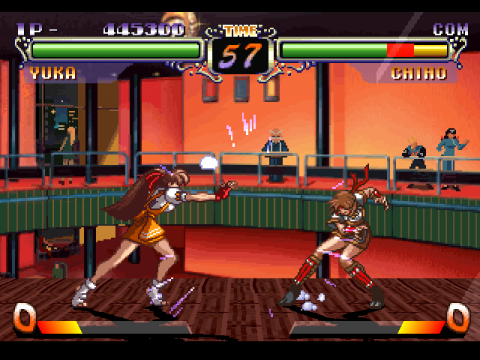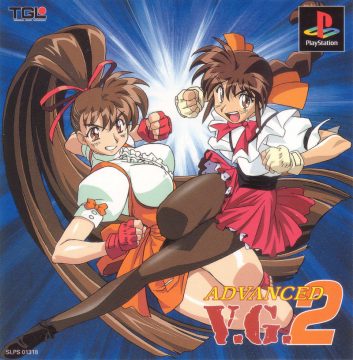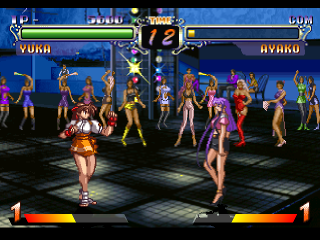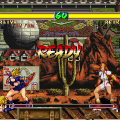- Variable Geo
- Advanced Variable Geo
- Variable Geo II: The Bout of Cabalistic Goddess
- Advanced Variable Geo 2
The first Advanced V.G. game is a very mediocre take on Street Fighter II formula, with some Fatal Fury thrown in for good measure. Of course, it’s understandable that it’s very hard to exceed the industry veterans in their field, especially when your prior experience was mainly adult games for Japanese PCs. TGL surely learned their lesson and focused their effort on the sequel, Advanced Variable Geo 2, released in 1998 exclusively for the Sony PlayStation. But is this one still another run of the mill fighter featuring a cast of pretty gals, or maybe there’s more than meets the eye?
The story picks up a year after Advanced V.G., with a new edition of the titular event taking place and a new challenger taking up the gauntlet. Meet Tamao Mitsurugi – a 14-year-old junior high-schooler who went into Yuka’s footsteps after witnessing her fighting live on TV. She admires the current champion Yuka Takeuchi as her personal idol (or “senpai”), and will do anything to meet Yuka and challenge her to a fight. However, Takeuchi is nowhere to be seen around, and Tamao sets out to find her, kicking some serious butt along the way.
All the challengers from the previous game make a return, and there are three new contestants available this time. Plus two unlockable boss characters.
Tamao Mitsurugi
The protagonist of the story. As Yuka’s fangirl no.1, she tries to copy her fighting technique (and appearance) while adding some moves of her own. Kinda clumsy, but an outgoing and cheerful person. She seeks a duel with Yuka to prove herself worthy of being her student. Essentially TGL’s take on Sakura. Voiced by Chinami Nishimura.
Kyoko Kirishima –
Another female ninja, although her fighting style resembles judo. Kyoko is Chiho’s cousin, sent with orders of apprehending and returning the runaway kunoichi to the clan if possible, or assassinating her if not. Perhaps the most realistic character in the series in terms of moveset and appearance. Voiced by Mari Maruta.
Saki Shinjou
A ruthless assassin hired to murder Reimi Jahana and possibly other V.G. fighters if ordered to do so. Doesn’t play by any rules, she’s into the tournament to do her nasty job. Her fighting technique is best described as brutal, remorseless curb-stomping, as she fights to kill, not just simply knock out her opponent. Voiced by Mari Mashiba.
Advanced V.G. 2 sports a slew of extra mechanics that enhance the gameplay depth when compared to the previous game. Although not original inventions of TGL, but rather heavily inspired by other popular fighting games of the time, these make the experience somewhat more enjoyable. First of all, there’s a bar in the lower part of the screen that fills up as fighters receive damage or perform attacks. It can be charged up to three times, and one point can be spent on more powerful form of a special attack (ie. Yuka’s super Idantensoku kick can inflict more damage to her opponent and send her flying to the other side of the arena!) or to perform a hyper attack at the cost of two points. It resembles the Power Gauge from King of Fighters ’94, albeit it doesn’t amplify character’s basic attacks (punches and kicks). This mechanic replaced the Fatal Fury-inspired desperation attacks of the previous game. Speaking of bars, the stamina bar is now doubled – the first half of one’s stamina is represented by a green colored bar and when that one is depleted, a yellow one shows up, and when that one is reduced to zero, the character is knocked out.
Secondly, alpha blocks (or alpha counters) straight from Street Fighter Alpha are introduced here and they work pretty much the same as in Capcom’s game. There are also target combos available for each character, and experienced players can even pull off an infinite combo. Finally, the players are able to super jump or a jump from a dash, which helps in the mobility department a lot, and opens up new possibilities of attacking opponents. In fact, there are a lot of strategies involving mid-air moves in this game.
The characters’ array of moves was also vastly expanded. Aside from the standard light/heavy punches and kicks there are other command moves executed by pressing both these and directional buttons at the same time. For example pressing the right or left button on the D-Pad and heavy kick when playing as Kaori will make her do a knee kick. This is useful for making various combos, along with super and hyper special attacks.
Advanced V.G. 2 has a new gameplay mode called Time Attack. As one can guess, the game pits you against all playable opponents (including mirror matches) and you’re expected to beat all of them in the shortest time possible. At the beginning of each match, the super attack bar is filled up to the max so you can strike with your best moves right off the bat and waste no precious time. The option to play a single duel against a chosen CPU opponent is removed in this game, but there’s a practice mode which allows the player to try out techniques on a dummy opponent (who stands still or is CPU-controlled), with the options of regenerating stamina bars or having the super bar already full for practicing super/hyper attacks.
Presentation-wise, the sequel is improved over its predecessor. Character sprites are now much more detailed and better animated, and so are the backgrounds. The camera zooms in and out depending how far characters are from each other, a gimmick used in games like Samurai Shodown and Art of Fighting, but as with those games, it causes the sprites to look more pixelated when the view is zoomed out. The girls’ portraits are now drawn in a slightly different style, which is reminiscent of Dirty Pair Flash, also courtesy of Mr. Kimura. Cutscenes in the Story Mode are in the same vein as the first game, but this time around dialogues are subtitled in Japanese. The intro is a short full-motion video showing all the characters (with some snippets taken from the OVA), accompanied by Masami Okui’s Endless Life as the opening theme. Some fully animated scenes are also seen during the course of the Story Mode. Overall it’s one of the best-looking 2D games on the system.
Takahiro Yonemura’s soundtrack features remixed themes from Advanced V.G. and some original works – it’s really good this time around. Most of the tracks are energetic enough for a fighting game, especially Ayako’s, Chiho’s and Yuka’s stage themes. He also made a PC-98 rendition of this album, despite the game never being released on that system, perhaps it’s a throwback to the naughty beginnings of the series. The voice actresses also did a better job portraying their respective characters, Yukana improved on Yuka’s voice in particular, as she now sounds more like a person of her age.
The first release of Advanced V.G. 2 in 1998 was handled by TGL themselves. The game was later re-issued in 2003 by Success (the company behind Cotton series) as a part of the SuperLite1500 offering. Finally, in 2017 it was made available on the PlayStation Network service in Japan for PS3, PSP and PS Vita consoles.
To sum it up, Advanced Variable Geo 2 might not be an innovative title, with derivative mechanics and character movesets still resembling those from the other games. But it somehow manages to take the best of both worlds (that is, Capcom and SNK) and deliver an enjoyable experience with anime girl flair to it, making the prequel pale in comparison. It’s also interesting how these games evolved from a really janky SF2 NSFW knock-off for the PC-98 into a very competent fighter that can be enjoyed by players of all ages. There were (and still are) A.V.G. 2 tournaments hosted every now and then in Japan, right next to Street Fighter and King of Fighters ones. Unfortunately, this is the peak of the series, as TGL decided to return the franchise to its adult game roots in subsequent games, eventually ditching the fighting aspect altogether, turning them into hentai visual novels with a modern, generic art style.





